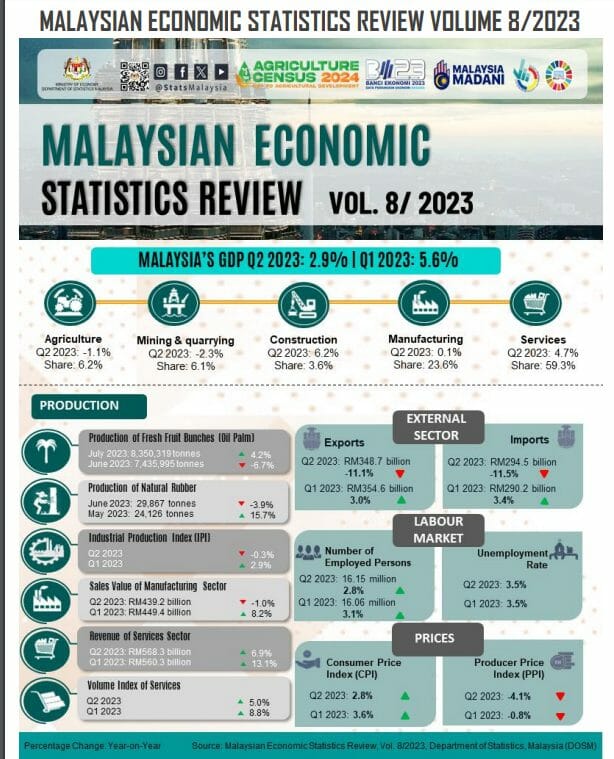The Department of Statistics, Malaysia (DOSM) released the Malaysian Economic Statistics Review (MESR) Vol. 8/2023 which focuses on the recent statistics released in June 2023 and some forthcoming statistics for July 2023.
Looking at the global economic scenario, based on the July 2023 report from the International Monetary Fund (IMF), there is a projected reduction in the annual average growth rate from 3.5 per cent in 2022 to 3.0 per cent for both 2023 and 2024.
Likewise, the anticipated trend indicates a decline in global headline inflation, which is expected to soften from 8.7 percent in 2022 to 6.8 percent in 2023, followed by a further slowdown to 5.2 per cent in 2024.
Chief Statistician of Malaysia Dato’ Sri Dr. Mohd Uzir Mahidin mentioned that, “Malaysia’s Gross Domestic Product (GDP) in the second quarter of 2023 moderated to 2.9 per cent after registering an increase of 5.6 per cent growth in the prior quarter driven mainly by the Services and Construction sectors.
“Accordingly, the monthly economic performance increased modestly at 0.7 per cent in April, went up to 5.6 per cent in May, and then eased at 2.4 per cent in June 2023. Temporary increases in domestic consumption and global demand propelled May 2023’s robust growth.”
Mohd Uzir added, on the recent economic indicators Malaysia’s Current Account Balance maintained a surplus of RM9.1 billion in the second quarter of 2023, as against RM2.9 billion in the corresponding period of the prior year. This surplus was underpinned by the net exports of goods.
The Foreign Direct Investment (FDI) recorded a lower net inflow of RM3.1 billion as compared to RM18.0 billion for the same quarter the preceding year.
While, Direct Investment Abroad (DIA) registered a net outflow of RM8.0 billion in Q2 2023 as compared to RM14.4 billion (Q2 2022).
On the other hand, Malaysia’s total merchandise trade decreased 11.3 per cent year-on-year to RM643.2 billion in the second quarter of 2023.
Exports fell by 11.1 per cent to RM348.7 billion, while imports decreased by 11.5 per cent to RM294.5 billion. The trade surplus went down by 8.8 per cent to RM54.1 billion.
In July 2023, the external trade continued its decline trend with a total trade at RM216.4 billion, as compared to RM 252.8 billion in July last year.
The value of exports recorded at RM116.8 billion, while imports was RM99.7 billion with a trade surplus at RM17.1 billion.”
He said: “The Manufacturing sector posted a decline in its sales value by 4.0 per cent to RM147.4 billion year-on-year in June 2023. During the second quarter of 2023, the Manufacturing sector experienced its first decline since the second quarter of 2020 (-16.5%), with a negative growth of 1.0 per cent as compared to the same quarter in the previous year.
“Correspondingly, Malaysia’s Industrial Production Index (IPI) fell 2.2 per cent year-on-year in June 2023, attributed to a contraction in the Manufacturing and Mining sectors, which declined 1.6 per cent (May 2023: 5.1%) and 6.4 per cent (May 2023: 2.9%), respectively.
On a month-on-month comparison, the IPI grew by 2.2 per cent as compared to 7.3 per cent registered in the previous month.”
On the Labour Force, he said, “Malaysia’s labour force rose 2.4 per cent year-on-year during the second quarter of 2023, totaling 16.73 million persons. This resulted in an increase of 0.8 percentage points in the labour force participation rate (LFPR), reaching 70.0 per cent.
“The number of employed persons continued to increase albeit at a slower rate of 2.8 per cent to 16.15 million persons during the quarter, with employment-to-population ratio reached 67.5 per cent. Concurrently, the number of unemployed persons reduced by 9.5 per cent to 581.4 thousand persons, registering unemployment rate of 3.5 per cent.”
From the prices perspective, Malaysia’s inflation continued to ease in June to 2.4 per cent, the lowest level recorded in the first six months of 2023.
Meanwhile, the inflation increased by 2.8 per cent in the second quarter of 2023. Malaysia’s inflation in July 2023 eased further to 2.0 per cent with the index points recorded at 130.5 as against 127.9 in the same month of the previous year.
Meanwhile, Malaysia’s Producer Price Index (PPI) decreased further by 4.8 per cent in June 2023 compared to 4.6 per cent decline in the previous month with most of the sectors’ indices showed downward trends.
In the second quarter of 2023, PPI for Local Production declined by 4.1 per cent primarily driven by the Agriculture, forestry & fishing (-24.6%). In July 2023, Malaysia’s PPI declined 2.3 per cent.
He added Malaysia’s economy is foreseen to grow moderately with easing of Malaysia’s short-term economic outlook. Targeted economic policy measures are anticipated to counter balance the existing challenges in the economy, increase the confidence of consumers and improve local businesses.
The economic prospect is in line with the Leading Index (LI) which declined 2.1 per cent in June 2023 by recording 109.8 points as compared to 112.1 points in the previous year.
Concomitantly, the monthly change of LI decreased 0.5 per cent in the reference month as compared to 1.7 per cent in May 2023.










